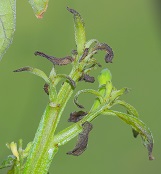| Home | Nature Weekly Index |
| Last Week | Next Week |
1 July 2018 | Water Primrose and Duckweed |

 In April, I discovered a seeding of
Water Primrose (Ludwigia hyssopifolia)
in the pot where I had planted a
Pinkroot (Spigelia anthelmia). It came as a surprise
since Water Primrose usually grows on wet soil next to rivers or ponds. To mimic its natural environment, I
started to water more for that pot to keep the Water Primrose going. It seemed to do well until the middle of
June when the young leaves at the top growing end of the plant started to shrink and curled up. Based on what I
had read, this was a symptom of broad mite attack. Broad mites are very tiny organism that is impossible to be
seen with the naked eyes. Judging from the damage done, it might be way too advance to reverse it.
In April, I discovered a seeding of
Water Primrose (Ludwigia hyssopifolia)
in the pot where I had planted a
Pinkroot (Spigelia anthelmia). It came as a surprise
since Water Primrose usually grows on wet soil next to rivers or ponds. To mimic its natural environment, I
started to water more for that pot to keep the Water Primrose going. It seemed to do well until the middle of
June when the young leaves at the top growing end of the plant started to shrink and curled up. Based on what I
had read, this was a symptom of broad mite attack. Broad mites are very tiny organism that is impossible to be
seen with the naked eyes. Judging from the damage done, it might be way too advance to reverse it.

 The seed of this Water Primrose might have arrived with the aquatic plants that I obtained from the
aquarium shop for my small fish tank. Thereafter, I might have unknowingly transferred it into the pot while I
was dumping the excess duckweed from my fish tank into the pot for recycling.
The seed of this Water Primrose might have arrived with the aquatic plants that I obtained from the
aquarium shop for my small fish tank. Thereafter, I might have unknowingly transferred it into the pot while I
was dumping the excess duckweed from my fish tank into the pot for recycling.

This duckweed, likely to be a Lemna species, was the latest floating aquatic plant in my fish tank. The other floaters added in the past had all succumbed to the snail attack or sub-optimal growth environment in the fish tank. It has probably came along with other much larger aquatic plants but started to spread quickly in my tank. I had to remove it periodically to prevent it from blanketing the entire water surface. Unlike the other larger size floaters, this duckweed seemed to be immune from attack by the water snails.
I had decided to discontinue my small aquarium soon. It was fun observing the interaction of the creatures in the tank. However, it was quite a hassle to arrange for someone to take care of the fishes when my whole family was away.